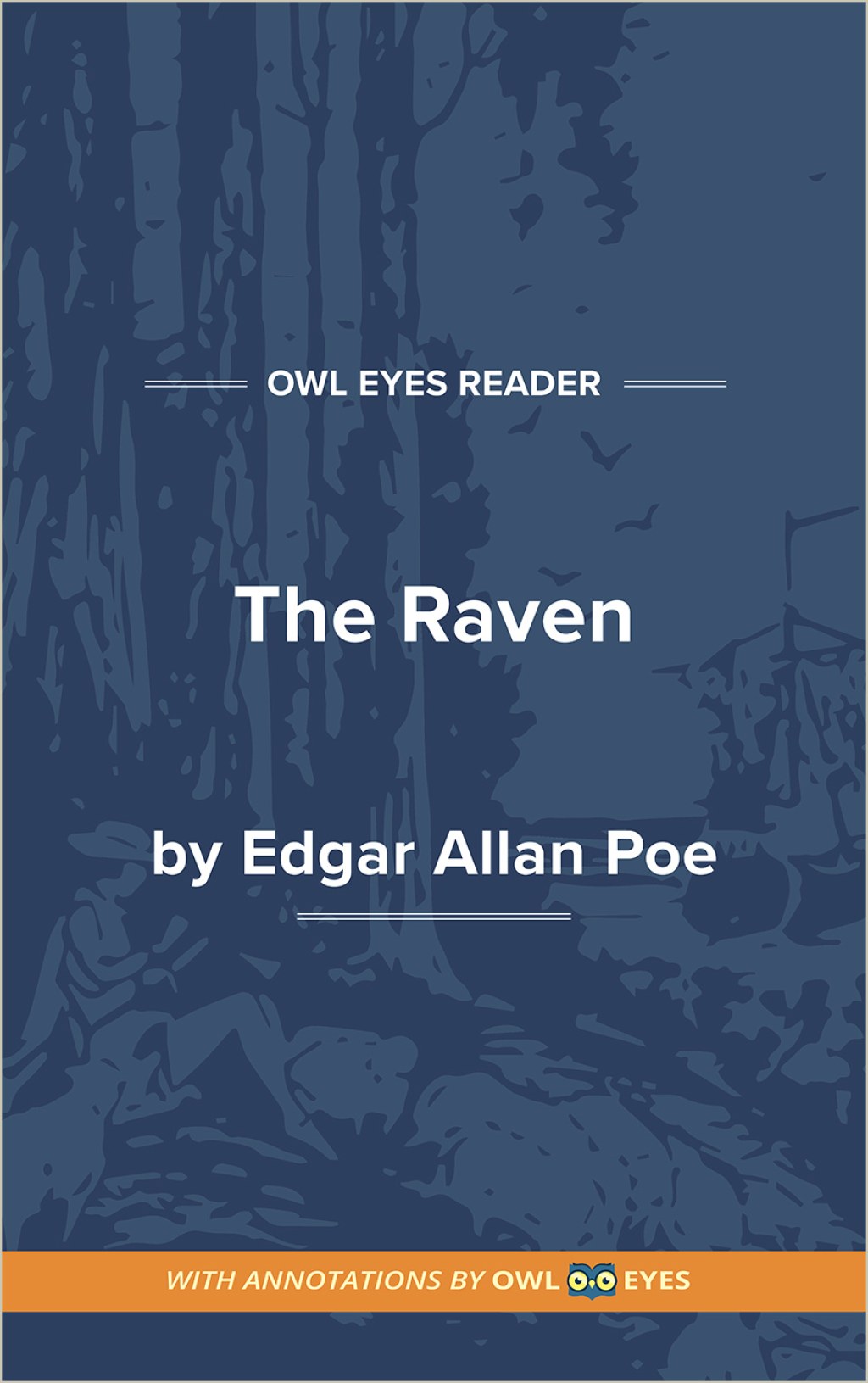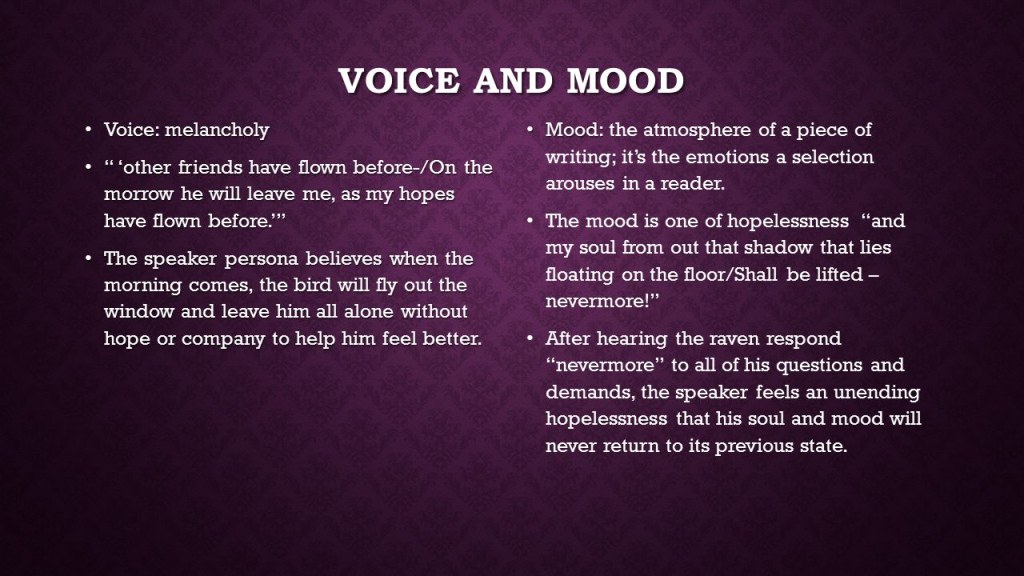Unveiling The Captivating Tone In The Raven: Experience The Spellbinding Power Of Edgar Allan Poe’s Classic
Tone in The Raven: Analyzing the Masterpiece of Edgar Allan Poe
Introduction
Dear Raven Enthusiast,
2 Picture Gallery: Unveiling The Captivating Tone In The Raven: Experience The Spellbinding Power Of Edgar Allan Poe’s Classic


Welcome to this captivating exploration of the tone in Edgar Allan Poe’s renowned poem, The Raven. As you delve into the depths of this literary masterpiece, prepare to be enthralled by the dark and mysterious atmosphere that Poe so skillfully creates. With its haunting tone, The Raven has captivated readers for generations, leaving an indelible mark in the realm of gothic literature. In this article, we will unravel the enigmatic tone of The Raven and delve into its various aspects, shedding light on its significance and impact.
Overview

Image Source: enotescdn.net
Before we embark on this journey, let us first understand what tone represents in literature. Tone refers to the author’s attitude or emotional disposition towards the subject matter or audience. It serves as a crucial element in conveying the intended message and evoking specific emotions in the reader. In The Raven, Poe masterfully employs various literary techniques to create a somber and melancholic tone, immersing readers in a world of despair and introspection.
Tone in The Raven: An In-depth Analysis
What is the Tone in The Raven?
🔍 The Mysterious Aura: Poe skillfully weaves a dark and mysterious tone throughout the poem. Through his vivid descriptions and haunting imagery, he creates an atmosphere of suspense and foreboding, leaving readers on the edge of their seats.

Image Source: slideplayer.com
🔍 The Melancholic Gloom: The Raven exudes a sense of melancholy that pervades the entire narrative. Poe’s use of desolate and mournful language contributes to the pervasive feeling of sadness and despair.
🔍 The Lament of Lost Love: Love lost is a central theme in The Raven, and the tone reflects the narrator’s anguish and longing for his departed lover. Poe’s use of repetitive phrasing and melancholic diction amplifies the emotional impact of the poem.
🔍 The Desperation and Isolation: The tone of desperation and isolation intensifies as the poem progresses. Through the use of vivid imagery and repetition, Poe emphasizes the narrator’s gradual descent into madness and his increasing detachment from reality.
🔍 The Supernatural and Gothic Elements: The inclusion of supernatural and gothic elements in The Raven adds to its eerie and foreboding tone. Poe’s use of symbolism and macabre imagery intensifies the sense of mystery and unease.
🔍 The Resonating Sadness: The tone in The Raven resonates with readers, evoking a deep sense of sadness and empathy. It explores universal themes of loss, grief, and the human condition, making it relatable to audiences across time and cultures.
🔍 The Enigmatic Endings: The tone subtly shifts towards ambiguity and uncertainty in the final stanzas of The Raven. This enigmatic conclusion leaves readers questioning the boundaries between reality and imagination, further enhancing the overall tone of the poem.
Who Does the Tone Affect?
🔍 The Reader: The tone of The Raven has a profound impact on the reader, eliciting a range of emotions, from fear and sadness to introspection and fascination. It immerses the reader in the narrator’s world, creating a lasting impression.
🔍 The Narrator: The tone directly influences the narrator’s state of mind, portraying his descent into madness and desperation. It reflects his emotional turmoil and adds layers of complexity to his character.
🔍 The Poet: Poe’s masterful manipulation of tone showcases his exceptional skill as a poet and writer. The tone serves as a vehicle for expressing his thoughts and evoking specific emotions in the reader.
🔍 The Literary Community: The dark and melancholic tone of The Raven has had a profound impact on the literary community, influencing subsequent works of gothic and macabre literature. It has become a touchstone for authors who seek to create a similar brooding and mysterious atmosphere.
🔍 The Critics: The tone of The Raven has been subject to extensive analysis and interpretation by literary critics. It serves as a focal point for discussions on Poe’s mastery of language, his exploration of the human psyche, and the impact of tone on the reader’s experience.
When Was The Raven Written?
🔍 The Composition Date: Edgar Allan Poe wrote The Raven in 1844, during a tumultuous period in his life. It was first published in the New York Evening Mirror on January 29, 1845, instantly capturing the attention of readers and establishing Poe as a literary sensation.
🔍 The Historical Context: The Raven was written at a time when gothic literature was gaining popularity, and the Romantic movement was at its peak. Poe’s poem, with its dark tone and exploration of the human psyche, perfectly encapsulated the zeitgeist of the era.
🔍 Poe’s Personal Life: The Raven is often seen as a reflection of Poe’s personal struggles and experiences. The poem’s tone mirrors the emotional turmoil he faced, including the loss of loved ones and his own battles with alcoholism and depression.
Where Does The Raven Take Place?
🔍 The Setting: The exact location of The Raven’s setting is left open to interpretation. However, the poem’s dark and gloomy tone suggests a dimly lit room in a desolate, gothic mansion. This setting enhances the overall atmosphere of mystery and foreboding.
🔍 The Imagined World: The Raven transports readers into the narrator’s internal world, where reality and imagination intertwine. The tone plays a crucial role in shaping this imagined realm, blurring the boundaries between the physical and the psychological.
Why is Tone Important in The Raven?
🔍 Setting the Mood: The tone in The Raven sets the mood and atmosphere, immersing readers in a somber and melancholic world. It establishes the emotional backdrop against which the narrative unfolds.
🔍 Conveying Emotions: By manipulating the tone, Poe effectively conveys a range of emotions, including sadness, despair, fear, and longing. The tone elicits an emotional response from the reader, ensuring a powerful and lasting impact.
🔍 Enhancing the Narrative: The tone enriches the narrative in The Raven, providing subtle hints and foreshadowing events to come. It adds depth and complexity to the story, engaging the reader on multiple levels.
🔍 Reflecting the Human Condition: The tone in The Raven reflects universal themes of loss, grief, and the fragility of the human psyche. It prompts readers to reflect on their own experiences and emotions, fostering a deeper connection with the poem.
🔍 Establishing Poe’s Style: The tone in The Raven exemplifies Poe’s distinctive writing style, characterized by dark and macabre themes. It showcases his ability to create a sense of unease and mystery, solidifying his reputation as a master of gothic literature.
How Does The Raven’s Tone Affect the Reader?
🔍 Eliciting Emotions: The tone in The Raven elicits a range of emotions in the reader, from fear and sadness to fascination and introspection. It creates a memorable and immersive reading experience.
🔍 Engaging the Senses: Through vivid descriptions and haunting imagery, the tone engages the reader’s senses, allowing them to imagine the dark and mysterious world of The Raven.
🔍 Provoking Thought and Analysis: The tone prompts readers to analyze and interpret the poem, fostering discussions on its meaning and significance. It encourages readers to delve deeper into the complexities of the human psyche.
🔍 Leaving a Lasting Impression: The tone in The Raven lingers in the reader’s mind long after they have finished reading. It leaves a lasting impression, ensuring that the poem’s themes and emotions resonate with them.
🔍 Inspiring Creativity and Exploration: The tone in The Raven has inspired countless adaptations, interpretations, and artistic creations. It continues to captivate and inspire readers and artists alike, fueling their creative endeavors.
Advantages and Disadvantages of Tone in The Raven
Advantages:
1. Immersive Reading Experience: The tone in The Raven creates an immersive reading experience, drawing readers into the world of the poem and evoking a strong emotional response.
2. Lasting Emotional Impact: The dark and melancholic tone of The Raven leaves a lasting emotional impact on the reader, eliciting a range of emotions and fostering a deeper connection with the poem.
3. Reflecting Universal Themes: The tone in The Raven allows readers to connect with universal themes of loss, grief, and the fragility of the human psyche, fostering a sense of empathy and introspection.
4. Establishing Poe’s Legacy: The distinctive tone in The Raven solidifies Edgar Allan Poe’s legacy as a master of gothic literature, inspiring future generations of writers and poets.
Disadvantages:
1. Potential Reader Discomfort: The dark and somber tone of The Raven may not appeal to readers who prefer lighter or more uplifting works, potentially alienating certain audiences.
2. Difficulties in Interpretation: The complex and layered tone of The Raven may pose challenges for readers unfamiliar with gothic literature or Edgar Allan Poe’s style, potentially hindering their understanding and appreciation of the poem.
3. Emotional Intensity: The intense emotional impact of The Raven’s tone may be overwhelming for some readers, making it difficult for them to fully engage with the poem.
4. Limited Range of Emotions: The predominantly melancholic tone in The Raven may restrict the range of emotions experienced by readers, potentially limiting their overall reading experience.
Frequently Asked Questions (FAQs)
Q: What inspired Edgar Allan Poe to write The Raven?
A: While there is no definitive answer, it is believed that the death of Poe’s beloved wife, Virginia, and his own personal struggles heavily influenced the creation of The Raven. The poem serves as a reflection of his grief and despair.
Q: How does the tone in The Raven contribute to the poem’s gothic elements?
A: The tone in The Raven plays a pivotal role in enhancing the gothic elements of the poem. It creates an atmosphere of suspense, gloom, and foreboding, which are hallmarks of gothic literature.
Q: How does Edgar Allan Poe’s use of symbolism contribute to the tone in The Raven?
A: Poe’s use of symbolism intensifies the tone in The Raven by adding depth and layers of meaning to the poem. Symbols, such as the raven itself, the bust of Pallas, and the chamber door, enhance the overall sense of mystery and darkness.
Q: Does the tone in The Raven evolve throughout the poem?
A: Yes, the tone in The Raven evolves as the poem progresses. It begins with a sense of melancholy and gradually intensifies, culminating in a tone of desperation and madness.
Q: How has The Raven influenced literature and popular culture?
A: The Raven has had a profound influence on literature and popular culture. It has inspired countless adaptations, references, and parodies in various forms of media, solidifying its status as a cultural phenomenon.
Conclusion
In conclusion, The Raven stands as a testament to Edgar Allan Poe’s mastery of tone and his unparalleled ability to evoke emotions in readers. Through its dark and mysterious atmosphere, the poem explores universal themes of loss, grief, and the enigmatic nature of the human psyche. The haunting tone of The Raven continues to captivate audiences, leaving an indelible mark in the realm of gothic literature. So immerse yourself in the dark world of The Raven, and let its tone envelop you in a whirlwind of emotions and introspection.
Final Remarks
As you embark on your journey through the haunting world of The Raven, it is essential to approach it with an open mind and a willingness to explore the depths of human emotion. Let the tone guide you through the labyrinthine passages of the poem, and allow yourself to be captivated by its enigmatic charm. Remember that the interpretation of tone is subjective, and each reader may experience it differently. So embrace the darkness, embrace the melancholy, and allow The Raven to leave an indelible mark on your literary soul.
This post topic: Raven



